Why “Into the Darkness” makes me worried about Star Wars, Episode 7.
Brief Background
I need to start with where I’m coming from: Warning: Spoilers Ahead
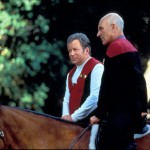 First, it’s important to know that while I really like Star Trek, I’m not an expert. I’ve never been to a convention and I’ve never donned a Starfleet uniform. However, I have seen the original series (ST:TOS), the Next Generation (ST:TNG), Voyager (ST:V), and all the movies through at least twice. I’ve seen Enterprise (ST:E) through once, and I’ve seen most of Deep Space Nine (ST:DSN). You can call me a trecker or a treckie, I’m fine with that… I’m just not an expert.
First, it’s important to know that while I really like Star Trek, I’m not an expert. I’ve never been to a convention and I’ve never donned a Starfleet uniform. However, I have seen the original series (ST:TOS), the Next Generation (ST:TNG), Voyager (ST:V), and all the movies through at least twice. I’ve seen Enterprise (ST:E) through once, and I’ve seen most of Deep Space Nine (ST:DSN). You can call me a trecker or a treckie, I’m fine with that… I’m just not an expert.
Second, I must admit that I was entertained by Into The Darkness (ST:ITD). Yes, the movie was exciting and entertaining, but it wasn’t very deep. Despite a number of nods to the fans, it seems to have missed the point of what Star Trek is.
Finally, I’ve generally seen only positive reviews for the latest pair of Star Trek movies. (Exception 1 , Exception 2) In general, reviews follow the “it was entertaining” and “Cumberbatch does a great Khan”. Additional comments sing praise to Abrams for “saving the series” (we owe J.J. Abrams). As a whole, there seems to be very little criticism from the fan base, and I think I understand why. That is, after a fairly disappointing ST:Enterprise series, we are adverse to criticize the reboot due to fears that such criticism would spell the end of Star Trek. The idea that the Star Trek franchise is one major disaster from disappearing forever. Perhaps I’m projecting here, but I do understand this reason for the lack of constructive criticism (although it is unusual for the fan-base to be so silent). I’m not the first to notice this silence, as evident in this meme posted about a week after the release of ST:IND.
So with that out of the way, lets go a little deeper.
Star Trek Themes
Star Trek is not just a science fiction series with a particular set of characters and rules. Superficially, it may seem that understanding the terminology (warp drive and tractor beams, phasers and photon torpedoes, Vulcans and Klingons) is the basis for the Star Trek universe. However, making that assumption is as big of a mistake as explaining away the Force with midichlorians.
To me, there are a few major themes that are necessary to really be Star Trek. One of these is missed entirely by the latest films (inclusion), and the other two (friendship and obedience) of which are only given lip service. We’ll start with a look at the last two.
Theme 1: Friendship
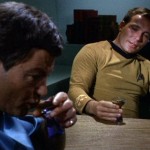 In TOS, we are introduced to the existing friendship between Kirk and McCoy. From the very beginning we understand that they have served together and that as a captain, Kirk needs someone he can confide with outside the command structure. Over the years, a camaraderie builds across the entire crew (most evident in the movies), but the strongest is that of Kirk and Spock. Further examples of this theme can be found in TNG series through the Data-La Forge, Picard-Guinan, and Crusher-Picard friendships.
In TOS, we are introduced to the existing friendship between Kirk and McCoy. From the very beginning we understand that they have served together and that as a captain, Kirk needs someone he can confide with outside the command structure. Over the years, a camaraderie builds across the entire crew (most evident in the movies), but the strongest is that of Kirk and Spock. Further examples of this theme can be found in TNG series through the Data-La Forge, Picard-Guinan, and Crusher-Picard friendships.
Where the Kirk-McCoy, Picard-Guinan, and Crusher-Picard friendships derive from an implied history, the Kirk-Spock and Geordi-Data friendships build over the length of the series. However, in the reboot, while the Kirk-Spock friendship is a major theme, it is baseless and feels fairly contrived. Why are these two friends? Because Spock Prime told them to be? In ST:2009, it is made clear that Spock doesn’t like Kirk. Then in ST:ITD, Kirk breaks the prime directive to save Spock.  This is done out of a feeling of responsibility for his crew (further demonstrated by the statement that Kirk has never lost anyone under his command), but not out of friendship.
This is done out of a feeling of responsibility for his crew (further demonstrated by the statement that Kirk has never lost anyone under his command), but not out of friendship.
As a result, I find the original “through-the-glass” scene that follows Spock’s death much more convincing than Spock’s ST:ITD outburst over Kirk’s death.
While Abrams has included the friendship theme in the film, it feels both forced and weak.
Theme 2: Questioning Obedience and the Consequences
Perhaps the most pervasive theme in Star Trek surrounds the questions of blind obedience and the associated consequences. This includes the necessity of a command structure aboard a starship and the dichotomy between the short and long term consequences of the prime directive. This command structure narrative was repeated throughout the early movies (returning to Vulcan to save Spock in The Search for Spock (ST:TSFS), returning to earth to save it from the probe in The Voyage Home (ST:TVH)), and the prime directive narrative was a major focus the STTNG and subsequent movies.
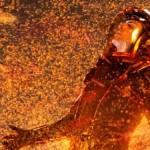 The theme of obedience is one of the areas where ST:ITD starts to get it right. First, in opening sequence when Kirk decides not to follow the prime directive. By choosing to rescue Spock from the volcano he is later forced to deal with the consequences of losing command. Then later, the theme is repeated both in the Scotty-Kirk interaction regarding the torpedoes aboard the ship. Finally, it is briefly touched again through Kirk’s interactions with Admiral Marcus.
The theme of obedience is one of the areas where ST:ITD starts to get it right. First, in opening sequence when Kirk decides not to follow the prime directive. By choosing to rescue Spock from the volcano he is later forced to deal with the consequences of losing command. Then later, the theme is repeated both in the Scotty-Kirk interaction regarding the torpedoes aboard the ship. Finally, it is briefly touched again through Kirk’s interactions with Admiral Marcus.
However, once again the result is fairly superficial as portrayed in the Abrams’ movies. This Star Trek theme is not just about questioning authority, it’s a deeper discussion of the implications of the decisions and an acknowledgement that there is no easy or necessarily “right” answer. For example, in the prime directive debate (from STTNG Pen Pals), the senior staff discuss in detail the consequences of disobeying the prime directive.
In ST:ITD, the difficult questions are bypassed by Spock’s query to Spock Prime about Khan. Can Khan be trusted? Is Khan simply a victim of circumstances and trying only to take care of his crew? Abram’s answer… just call up the old Spock. Its an easy answer on multiple levels.
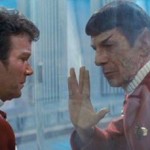 But Star Trek is supposed to be about hard answers to the difficult questions surrounding making decisions. Doing what is morally right … or what is logical … or what is good for the many … or what is good for the few (or the one). The questions of humanity that are contrast against the logic of Spock and Data, or the overly emotionalized Doctor. Questions of sacrifice, of ethical dilemmas [videos], of responsibility, of security , of risk , of the fallibility of man. And sometimes, these require a bit of on-screen dialog. Consider Picard’s 2 minute long conversation with Q about his life’s decisions.
But Star Trek is supposed to be about hard answers to the difficult questions surrounding making decisions. Doing what is morally right … or what is logical … or what is good for the many … or what is good for the few (or the one). The questions of humanity that are contrast against the logic of Spock and Data, or the overly emotionalized Doctor. Questions of sacrifice, of ethical dilemmas [videos], of responsibility, of security , of risk , of the fallibility of man. And sometimes, these require a bit of on-screen dialog. Consider Picard’s 2 minute long conversation with Q about his life’s decisions.
Conversely, ST:2009 and ST:ITD are full of action. Action is easy. Action is fun. Trying to successfully add philosophical and honest debate into a movie is hard. You risk boring your audience and sounding self righteous. It is a huge risk to make a statement, to add to the collective consciousness without sounding cliche. There are plenty of examples of how this can go wrong… look to the difficulty The Final Frontier (ST:TFF) had in dealing with the sanctimonious Sybok or the cringing exchange between Uhura and Lincoln . There are even cases where Star Trek’s attempts to ask difficult questions have been banned. But I would argue that the risk is worth taking in order to be true to the themes of Star Trek.
Theme 3: Inclusion
It is in the theme of inclusion that Abrams most misses the mark the most.
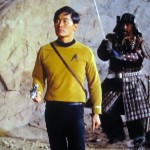 Specifically, Roddenberry’s message for Star Trek was that we are all humans, equally valuable and equally important. Now, consider the inclusion of a Japanese pilot (Hikaru Sulu) 20 years after the of World War 2 (the modern equivalent to 1993) and a Russian ensign (Pavel Chekov) during the height of The Cold War, both as bridge officers. This is even more significant when you know that George Takai and family (along with 7000 other Americans) were sent to Japanese internment camps during WWII. Imagine the risk Abrams would need to take to create a modern equivilent, that is the addition of Afghan and Iraqi officers to the bridge of the Enterprise.
Specifically, Roddenberry’s message for Star Trek was that we are all humans, equally valuable and equally important. Now, consider the inclusion of a Japanese pilot (Hikaru Sulu) 20 years after the of World War 2 (the modern equivalent to 1993) and a Russian ensign (Pavel Chekov) during the height of The Cold War, both as bridge officers. This is even more significant when you know that George Takai and family (along with 7000 other Americans) were sent to Japanese internment camps during WWII. Imagine the risk Abrams would need to take to create a modern equivilent, that is the addition of Afghan and Iraqi officers to the bridge of the Enterprise.
While it is true that the reboot includes multiple races represented by Sulu (this time played by South Korean born John Cho), Uhura (Zoe Saldana), and Chekov (Anton Yelchin), this doesn’t represent the theme of inclusion. Other than Checkov, the crew members are all very westernized, but in ST:TOS Roddenberry fought to ensure that Star Trek was not simply an “American” ship. I’ve even read that Roddenberry fought early efforts by the network to include American flags on the bridge.
In other words, the theme of inclusion was not just a question of having a multiracial crew, but a multicultural one in which national identity is replaced by planetary identity. That is, Sulu is not simply a Japanese-American, he is a human with Japanese culture. Likewise, prior to the reboot Uhura had a Swahili/Bantu cultural background. Other examples include Picard’s French culture, Chekov’s Russian culture, and Scotty’s… well Scottish culutre. There is not westernization, but instead a humanization.
The theme of inclusion was furthered by the addition of La Forge as a blind engineer in STTNG, then later giving leadership roles to Captain Janeway and Captain Sisko in the subsequent television series, sending a clear message that it was time to move beyond white-male leadership.
 Further, Star Trek has repeatedly pushed our culture on the nature of human relationships. This includes both interracial (in ST:TOS) and LGBT (in ST:TNG) relationships at times when they could not otherwise be found on mainstream television. (Read more)
Further, Star Trek has repeatedly pushed our culture on the nature of human relationships. This includes both interracial (in ST:TOS) and LGBT (in ST:TNG) relationships at times when they could not otherwise be found on mainstream television. (Read more)
Of course the theme of inclusion is not limited to humanity. The message is clear that all planetary races play a key role within success of Starfleet, including Klingons (Worf and B’elanna Torres) and Vulcans (Spock and Tuvok). Through this, Star Trek has had a theme of pushing the boundaries of inclusion, making the current audience constantly question their preconceived notions by repeatedly including a one-time “ultimate enemy” as a valued member of Starfleet. From Japanese to Russian, Klingon to Borg .. the series has constantly sought to personalize individuals.
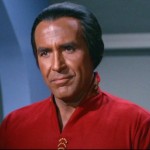 Yet in the reboot, not only are the characters of Sulu and Uhura westernized, the personification of human genetic perfection, represented by the Indian (potentially Sikh) Khan Noonien Singh is played by the very English Benedict Cumberbatch. So while I might agree that Cumberbatch plays a great villain, he breaks the theme of inclusion.
Yet in the reboot, not only are the characters of Sulu and Uhura westernized, the personification of human genetic perfection, represented by the Indian (potentially Sikh) Khan Noonien Singh is played by the very English Benedict Cumberbatch. So while I might agree that Cumberbatch plays a great villain, he breaks the theme of inclusion.
Further, the only significant non-human addition to the Enterprise crew in the reboot is the engineer Keenser. Unfortunately, Keenser’s only role within the movie is as comic relief, adding a sidekick to the over-the-top slapstick antics of Montgomery Scott’s character. It is fortunate that Keenser does not speak in the film, otherwise a comparison to Jar Jar’s character in SW:TPM would be hard to avoid.
Additional Notes
 In an effort to be fair, there were a few things (other than being entertaining) that I think ST:ITD did well. The initial scene in which the crew is running through the alien forest of very red trees was excellent. When it comes to special effects, the expectation for planetary diversity has always been a bit disappointing. Its nice to see a non-earthlike planet consisting of something other than a series of caves.
In an effort to be fair, there were a few things (other than being entertaining) that I think ST:ITD did well. The initial scene in which the crew is running through the alien forest of very red trees was excellent. When it comes to special effects, the expectation for planetary diversity has always been a bit disappointing. Its nice to see a non-earthlike planet consisting of something other than a series of caves.
Also, for the first time the interior scenes of the ship seemed to better represent the expected scale of the Enterprise starship, especially that of the engine room. Unfortunately, this felt overdone in the later scenes that appear to be filmed in a fuel depot (see spinning gravity sequence linked below).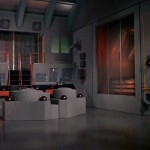
This leads to a few more complaints. The first is an acknowledgement that over the almost fifty years of Star Trek episodes, there was bound to be bad writing, acting, and eventual cliches. There are so many bad Star Trek quotes that many people forget the great ones. However, whether out of a sense of obligation or a desire for a cheap laugh, the latest set of films spat out the more infamous cliches as if they couldn’t get through them fast enough. But none was as contrived as, “Damn it, man, I’m a doctor, not a torpedo technician!”
 Another complaint is the over reliance on slapstick for comedy relief. While ST:ITD had less than ST:2009, the slapstick wasn’t funny back in ST:TFF and it was even more difficult to watch in ST:2009. This includes both the hand-swelling scene, or the even worse “Scotty beamed into the coolant tube”.
Another complaint is the over reliance on slapstick for comedy relief. While ST:ITD had less than ST:2009, the slapstick wasn’t funny back in ST:TFF and it was even more difficult to watch in ST:2009. This includes both the hand-swelling scene, or the even worse “Scotty beamed into the coolant tube”.
At least the hand swelling was a plot device to get Kirk onto the ship. The tube incident was purely an attempt at comic relief and must have cost a fortune to construct the set and film. Consider instead this bit of memorable humor from ST:TFF in which budgets were spent on good writing.
There were also a few scenes of fairly bad science. For example, the physics of the spinning gravity sequence was difficult to watch. A ship in orbit (or even one falling out of orbit) would be in a state of microgravity, leaving everyone feeling “weightless”, not a spinning gravitational field.
Audience
This all leads to the root problem. That is, the desire to make Star Trek for everyone. A good friend of mine (who happens not to be Star Trek fan), wrote the following update on Facebook, “If [Abrams] can make a movie that much fun to watch with something as lame as Star Trek, I cant wait to see what he can do with Star Wars”
And I think that’s the point right there. Star Trek is not for everyone. Star Trek is for us, the nerds, the geeks, the dorks .. the treckies. It is literate with characters often quoting novels , poetry , various historical references . Star Trek places high value on math as well as pure and applied science with a science officer on the bridge and major role for the chief engineer. And Star Trek is philosophical, driving us to ask deeper questions on the nature of humanity .
It is the depth of these themes that serve to make both Star Trek and Star Wars timeless. And it is the lack of this depth that make movies like Taken entertaining, yet fairly shallow and not really that interesting in the long run.
Looking across the thousands of hours of Star Trek entertainment that have been created, it can be easy to find the occasional really bad episode. There are even a couple not-so-great movies. But with JJ Abrams, we’re seeing Star Trek movies that are entertaining but just miss the point. It is for this reason that I worry about Star Wars. Will it just end up with a lot of shots of the death star with lens flare? (I guess that link proves I’m not the only one with complaints.)
Anyway, this post is way off from my normal topics, but I didn’t really have anywhere else to post it. My apologies if this seemed to be sitting in an odd location.
